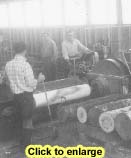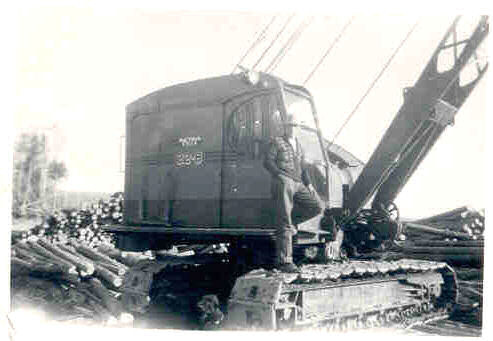


Several
changes occurred for workers in the forest industry during this time span.
During the 1950s, lumberjacks traded bucksaws for mechanical saws. Production
and salaries increased. By the end of the 1950s, lumberjacks earned between
$8 and $10 per thousand feet (Excerpt from Le Droit). Companies often distributed
bonuses to loggers who "finished the run", or the logging season. Mill
workers, on the other hand, earned around 60 cents per hour.
Life in lumber camps, more precisely in Henry Selin Forest Products' camps, is recounted in Arthur Desgroseillers' novel, "La mort du bûcheron." In a typical day at camp 8, a bell wakes up the men at around 5 a.m. They eat breakfast at the camp's kitchen and prepare a lunch for the day. At around 7 a.m. they make their way to the stables where the carters harness their horses, which the "barnboss" fed and watered at 5 a.m. Lumberjacks and carters then make their way to their "strip", a section of forest where they are responsible to harvest timber, and the work day begins. Lumberjacks return to camp at around 4 p.m. Diner is served at 6 p.m. and the men head to bed at 9 p.m. During the first half of the 1960s, major developments occurred in the mechanization of forestry operations. The use of wheeled skidders to haul timber out of the forest gradually rendered the use of horses obsolete. This mechanization resulted in a reduction in the number of workers in the industry. Two workers, a lumberjack and a skidder operator could now accomplish a task that hitherto required several men. |
||
 |
||
|
(picture donated by Mr. Réginald Veilleux) |
||
| However, as the number of workers required in the forest diminished, the number of workers in sawmills and factories increased with the rise in production. New sawmills with increased output potential were built in Hearst and Calstock, in addition to the Levesque Plywood factory. Hearst's population rose with the arrival of new workers. | ||
|
||
Meanwhile,
unionization made a marked appearance. After the Second World War, many
forest workers employed by pulp and paper mills of the region were represented
by the Lumber and Sawmill Workers Union. During the 1940s and 50s, this
union attempted on several occasions to become the representative for workers
of the lumber industry. The majority of sawmill employees, however, did
not support this initiative. Mill owners also feared the possible unionization
of their employees, as made evident by an incident in 1954 when The Henry
Selin Forest Products was fined for firing employees who belonged to
a union (Except from Le Droit).
Union representation was accepted by a majority of Fontaine Lumber employees in 1957. This measure, however, was struck down the following year when René Fontaine moved his mill north of Calstock and operated under the name Polar Lumber. In the early 60s, Henry Selin Forest Products employees unionized. The signature of the first contract in the fall of 1961 was preceded by a strike. Employees obtained a pay hike and a reduction in the work week. Mill workers now earned more than $1 per hour. By
1969, the salary of mill workers varied between $2.46 and $4.50 per hour,
depending on the employee's specialization and responsibilities (Except
from Évolution de l’industrie forestière à Hearst,
1969).
|
||
.jpg)
.jpg)

